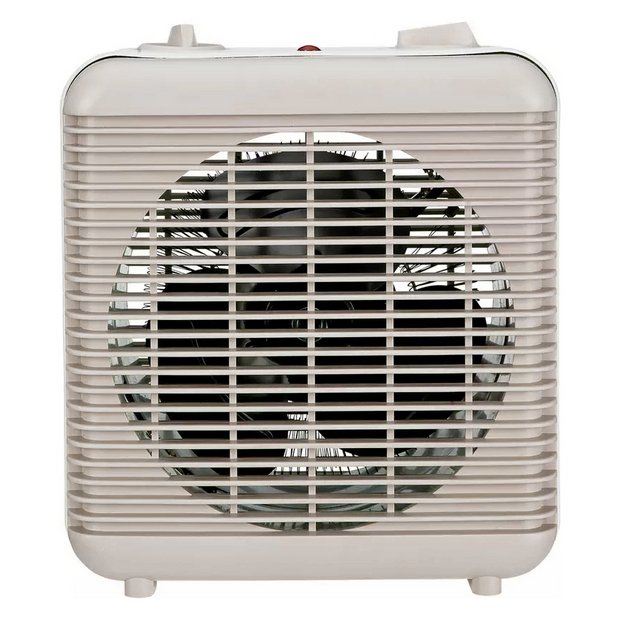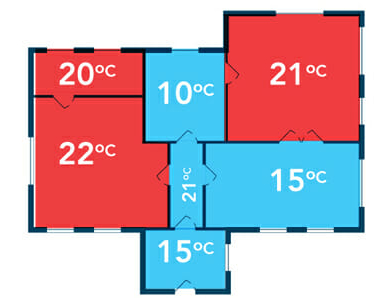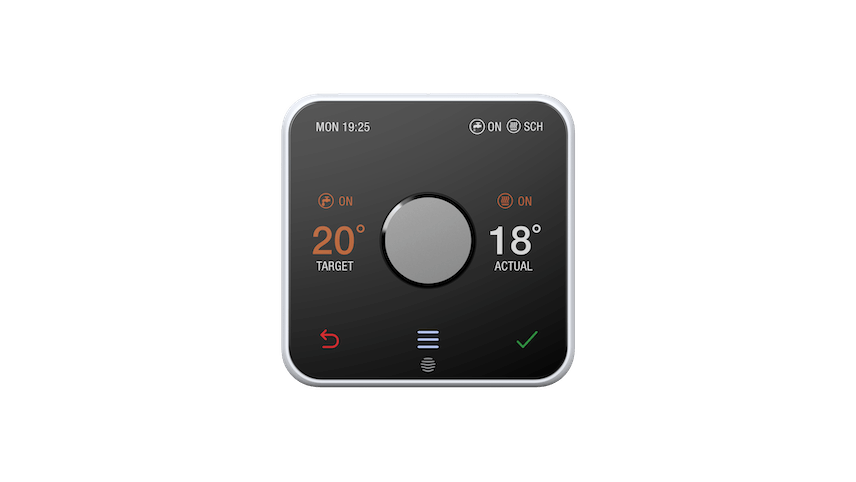- Home
- Scotland's changing climate
- Urban Housing in Scotland
- Maintenance
- Ventilation
- Airtightness
- Insulation
- Lofts - insulation at ceiling level
- Lofts - insulation at rafter level
- Cavity wall insulation
- Solid Walls: Internal vs External Insulation
- Internal Solid Wall Insulation (IWI)
- External Solid Wall Insulation (EWI)
- Timber frame retrofit
- Windows and doors
- Openings in 'historical' buildings
- Openings in 'non-historical' buildings
- Ground floors
- Suspended floors
- Suspended floors - from below
- Suspended floors - from above
- Solid floors
- Insulation materials
- Building science
- Space heating
- Solar energy
- Product Selector
Reducing the Demand for Space Heating
All of the issues in the following section discuss how the amount of heat needed from the outset is reduced, making the task of providing heat less onerous and costly.
Insulation and Airtightness
In the battle to save energy, reduce carbon emissions, increase comfort and reduce fuel costs, there is no doubt that insulating a building effectively is the number one priority. This guide shows how this effort can be improved to benefit from actual savings, not just on paper. The second priority is airtightness because the heat will bypass the insulation through all the inevitable gaps if this is not managed. When considering a typical uninsulated property, carrying out the insulation measures described in the guide should result in savings of at least 50% and, if carried out thoroughly, perhaps even 90%. If heating a building is a problem that needs to be solved, then reducing this problem to 10% of its original size will result in a much smaller problem to solve – both in initial and long-term costs – with more options for possible solutions.
Keeping it Cooler
Average living room temperatures are now three degrees warmer than in the 1970s as people find it cheaper to keep homes warm. Whilst this is largely welcome, it raises a question about potentially unnecessary carbon emissions. Historic Environment Scotland has published an excellent document (TP14 'Keeping Warm in a Cooler House'), which discusses how people can remain comfortable in lower temperatures. It is important to emphasise that this does not mean 'putting up with' colder temperatures. The publication's authors demonstrate how it is possible to be comfortable in a generally cooler home (around 16 degrees) if supplementary heating is used when required and appropriate clothing is worn.


The study arose from a concern that people are trying to ‘force’ older buildings to maintain contemporary ideas of comfort for which the buildings were not designed and that this mismatch between traditional properties and modern concepts of comfort was causing not just high fuel bills but broader problems for buildings and their occupants. Ultimately, the study shows that the increasingly high temperatures we expect in our homes are not necessarily healthy for most. In the drive towards sustainable solutions, the potential to reduce energy consumption whilst maintaining comfort is too large to ignore.
The underlying logic is that, ultimately, we are not trying to keep homes warm; we are trying to keep people warm, and there are more creative ways of achieving this than heating a whole house. In practice, this might mean that, in most cases, central heating systems can be turned down while supplementary heating (see below) is used when necessary.
Supplementary Heating
Many people living in cold homes will be familiar with supplementary heating; their main heating system does not provide sufficient warmth, and they are forced to use small gas or electric heaters to provide supplementary warmth and make things tolerable. Unfortunately, these ad-hoc solutions are often more expensive and, like
gas heaters, can create other problems with air quality and humidity. Generally, these heaters tend to heat a single room, but at least they are responsive and can be turned off easily when not required. The principle is that these heaters are not the main system; they are used whenever needed and only heat a small area to keep costs down.
The above situation is the unhappy cousin of the far more positive option discussed in the previous section and championed by Historic Environment Scotland. In this scenario, we consider that the house can be maintained at a reasonable temperature, but this temperature is lower than usual, acknowledging that not all areas need to be kept warm to the same degree.
Recognising that people in the house need to be kept a little warmer than this, especially when resting or when not moving (for example, seated
at a desk), supplementary heating provides warmth close to and focus on the person. The humble hot water bottle is the most obvious example, but several other examples exist. Heated foot pads can keep feet warm when sitting; small radiant panels can be used under desks to keep legs warm; heated seats can keep backs and bottoms warm; and other solutions that operate locally to provide warmth and comfort. Beyond heated car seats and hot water bottles, the concept is not widely known in the UK; more examples exist in Europe and the US, but the potential to save energy and improve comfort is significant.

A 2kw portable fan heater.
Zoning
It is possible to reduce energy consumption and the need for heating by considering the patterns and types of use in each room of the house, allowing different spaces to be heated differently. For example, in some houses, guest bedrooms are rarely, if ever, used and could be kept at a much lower temperature than regularly used spaces. Another example is any room where people are generally standing or busy, such as a kitchen or workroom, so the need for heat is less. Many people keep their bedrooms cooler than other rooms, which makes sense because most of the time is spent beneath sheets or a duvet. Conversely, living rooms and bathrooms tend to be kept warmer.
The practical implication is that the heating system choice should allow different parts of the home to be heated differently. This can be done by fitting every radiator with a thermostatic radiator valve (TRV) or providing the house with two or more different ‘zones’ that can be controlled differently. This is readily done with more automated central heating systems, but can also be achieved in a more fundamental sense by heating the living room of a house with a wood stove, for example, making that the warmest room, while leaving doors open or closed as necessary to allow heat into other rooms as required.

Use thermostatic valves to deliver the appropriate temperature for each room.
Timers and Programmers
Most people are familiar with timers and programmers for central heating systems. It is the ‘when’ corollary of the ‘where’ of zoning noted above in which the heating system is set to come on only at times to suit the occupants. Typically, heating systems are set to come on for an hour or two in the morning just before and during the breakfast rush before everyone exits for work and school, coming on again for longer in the evening before switching off around the time people go to bed. Programmers allow the system to be set over different days to reflect weekday/weekend patterns. The building regulations require that all new buildings be fitted with timers and programmers. In any given retrofit situation, it is important to ensure that, where possible, the heating system can be as closely controlled as possible.

Thermal Sensitivity of the Human Body 1
Cool Heads and Warm Feet
Most people know intuitively that they feel better when their heads are cool and their feet warm. While a relatively mundane observation, this
is an important strategic goal for heating systems. It can allow designers to ensure comfortable conditions using less energy by working with the human body’s inbuilt preferences. Human bodies have adapted over millennia such that different parts of the body – mainly the head, hands and feet – respond more readily to temperature, meaning that working closely with these can increase the effectiveness and thus efficiency – of any given heating system. The same level of comfort – less energy.
The goal is to try and create a situation in which feet are warm while heads are relatively cool. This does not serve as a rigid rule, but it does mean that underfloor heating, for example, is far preferable to ceiling-mounted heating, which creates more or less the opposite effect. Less obviously, it also means that systems that primarily heat air (which then rises towards the ceiling) are less effective because they largely provide heat to the wrong part of the room. They have to work harder, using more energy so that the warmer air builds up against the ceiling and down towards the floor, and this disadvantage is amplified where ceilings are high, which is often the case in older buildings.
Thermal Sensitivity of the Human Body 2
A Preference for Radiant Heating
Throughout human evolution, we have evolved with the sun, and ever since the first human tamed fire, we have also benefitted from this source of warmth. The sun and fire provide largely radiant heat, and humans have evolved to respond well to this. Importantly, radiant sources of warmth can keep us warm even if the air is cold. This is because, very broadly, we gain or lose about half of our warmth through radiant heat transfer and only about a quarter each from convection and conduction. The point is that if we use radiant heat, we can use less energy to affect the same comfort levels.
Although it is easy to visualise warmth from the sun and fire, a less obvious aspect of radiant comfort is that humans gain and lose heat all the time, not just from these two heat sources but to and from our surrounding surfaces. If you stand in an empty room, your body surface is gaining and losing warmth in relation to the room's floor, ceiling and walls. Given that we are largely vertical in form, most of this heat transfer happens between us and the walls. If the walls are warmer than us, we will feel warm even if the air is cool; if they are colder, we will feel cold, even if the air is warm.
Typically, this radiant heat transfer is rather uninteresting; houses are warmed by radiators, which heat the air, but they and the warm air also heat the surfaces, which are fairly warm. Everything in the house – air, walls and the people inside – is reasonably warm, so the exchange of warmth between things is minimal. However, we are interested in optimising heating systems to use less energy while still keeping comfortable, so what is interesting is when we start to manipulate things. By explicitly designing buildings with ‘warm surfaces’, we can use less energy while maintaining or improving comfort. Ideally, these warm surfaces are on the floor (underfloor heating), but an equally effective solution is ‘warm walls’. Another method that exploits the benefits of radiant heating is the use of ‘radiant panels’, which are separate metal or ceramic panels heated usually with electricity.
